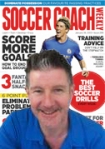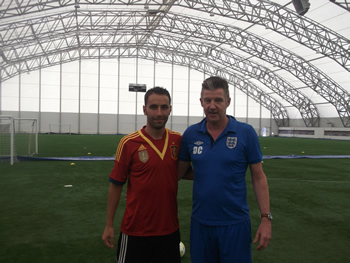If you want your players to create goal scoring chances like the midfield players at Barcelona, try this exciting and fast-moving game and you’ll soon see the benefits.
Filed under: Attack, Dave Clarke, defence, Soccer Coaching, Soccer Fitness, Soccer News, Soccer Refereeing, Soccer Skills, Soccer Team Management, Soccer Training | Tags: football tactics, soccer tactics, tactics

 Line-breaking passes are those that go through a line of the opposing team’s formation.
Line-breaking passes are those that go through a line of the opposing team’s formation.
For example, a pass that goes between two opposing defenders is known as a line-breaking pass because it breaks through the defensive line.
A line-breaking run is similar to a line-breaking pass, although in this case it is the player, not the ball, that breaks the line.
Line-breaking runs usually occur in the final third of the pitch when a forward or midfielder runs through the defensive line and into a goal-scoring position. Cristiano Ronaldo is an expert at making line-breaking runs.
Taken from David Clarke’s manual
Filed under: Attack, Dave Clarke, defence, Soccer Coaching, Soccer Fitness, Soccer News, Soccer Refereeing, Soccer Skills, Soccer Team Management, Soccer Training | Tags: tactics, winning

Defending

 A defensive diamond is created when a team’s midfielder drops back from midfield towards his own goal (also known as dropping deep) to form a diamond shape with his goalkeeper and two centre backs. This enables the team to play out of defence against a team playing with two forwards.For this to happen, the team’s full backs must go high and wide, and the midfielders and forwards must go into advanced positions to really exaggerate the space for the players to play out of defence.
A defensive diamond is created when a team’s midfielder drops back from midfield towards his own goal (also known as dropping deep) to form a diamond shape with his goalkeeper and two centre backs. This enables the team to play out of defence against a team playing with two forwards.For this to happen, the team’s full backs must go high and wide, and the midfielders and forwards must go into advanced positions to really exaggerate the space for the players to play out of defence.
David Clarke’s Soccer Tactics Made Simple explains 58 of the game’s tactical concepts in simple, plain language. Read more.
Filed under: Attack, Dave Clarke, defence, Soccer Coaching, Soccer Fitness, Soccer News, Soccer Refereeing, Soccer Skills, Soccer Team Management, Soccer Training | Tags: passing, tactics, technique
BACK FOOT the ball is played to the foot furthest from the defender
FRONT FOOT the ball is played to the foot nearest the passer

Ball Control and Footwork
 The foot furthest away from the ball is known as the back foot.When receiving the ball, with time and space to turn, a player should open his body andreceive the ball on his back foot to dribble forward.
The foot furthest away from the ball is known as the back foot.When receiving the ball, with time and space to turn, a player should open his body andreceive the ball on his back foot to dribble forward.
Front foot refers to the foot nearest the ball.
When receiving the ball under pressure from an opponent and unable to turn, a player must receive the ball on his front foot and protect the ball by placing his body between the ball and the opponent. Now the player can choose to pass to a team mate or turn away from the opponent using a quick skill or trick=.
David Clarke’s Soccer Tactics Made Simple explains 58 of the game’s tactical concepts in simple, plain language. Read more.

Filed under: Dave Clarke, Soccer Coaching, Soccer Fitness, Soccer News, Soccer Refereeing, Soccer Skills, Soccer Team Management, Soccer Training | Tags: attack, block, centreback, defender, defending, puyol, tackle, tactics
By David Clarke
Barcelona’s captain Carles Puyol is known for his intense commitment and strength as a defender. According to Barcelona’s head doctor, Puyol is “the strongest, who has the quickest reactions, and who has the most explosive strength”.
Love him or loathe him, he is the sort of player who gives everything for the cause, who prides himself on being alert to wave after wave of attacking threats in and around the box. He is also the sort of player who is not afraid to put his body in harm’s way. And he’ll grab you the odd goal or two.
Ensuring that your players are back on their feet after a good tackle or clearance and ready to combat a second wave of danger is essential.
To keep them alive and reactive, here’s a defensive move that asks for quick reactions and tireless commitment to the cause.

How to set it up:
-
Create a playing area measuring 10×10 yards.
-
The drill requires four servers and one designated defender.
-
Each server starts on a different side, with a ball.
-
Place your defender in the middle – his job is to react to a different serve from each player around the area. After each serve, his task is to keep the ball within the box.
Getting started:
-
Starting on the left-hand side, server 3 throws the ball up for server 1 to head into the middle. The defender tries to stop the ball from going out of bounds.
-
Immediately, server 2 passes a ball towards the opposite line. The defender must now react, running to slide and stop the ball from crossing the line.
-
Now server 3 dribbles onto the pitch and attempts to get to the line opposite. The defender tries to stop him.
-
Finally, server 4 throws the ball over the defender’s head and attempts to run around him to win it back. The defender’s task is to shield the ball, letting it run over the line. If the ball stops dead before the line, he can then kick it clear to the left or the right.
-
Now rotate so that a different player acts as the defender.
Why this works:
Adopting the mindset that a defender’s job is rarely complete is absolutely vital if players are to counter all of the threats on a match day. After each phase of this drill, the defender needs to be alert to a new test, reacting quickly to each ball and clearing the danger.
Each test offers a new skill, and provides you with a quick-fire snapshot of where the defender’s game can be improved.
Filed under: Dave Clarke, Soccer Coaching, Soccer Fitness, Soccer News, Soccer Refereeing, Soccer Skills, Soccer Team Management, Soccer Training | Tags: angle, attack, cover, defend, distance, support, tactics
In this 3v3 game, you can get players to learn about providing support and being in the right position to cover when the ball is lost.
Support play
In a 3v3 situation, one of the most important jobs is to support the player on the ball. There should be forward support to provide an attacking outlet and rear support to give a defensive outlet.
A pass back to the player covering the defensive area of the team can be an attacking move because it can open up space on the other side of the pitch.
Support players need to think about:
- The angle of support
- The distance of support
Getting this right means the supporting player:
- Has a full range of forward vision.
- Can receive the ball comfortably.
- Has space to pass the ball to a team mate.
- Can move forward into space in front of them.



How to set it up
In this game, rear support comes from the goalkeeper who must move out of his goal when the team is attacking. When the team is in possession of the ball none of the three players are allowed in their defensive end zone.
Goalkeepers have to support from the rear and be ready to get back if the team lose the ball. So the attacking team always has an empty end zone so the defending team can quickly attack if it wins the ball.
The attacking team therefore has a 3v2 advantage in the middle of the pitch. The defending team can have players in any zone, but when it wins the ball and attacks, all players including the goalkeeper must move out of the defensive end zone.
Filed under: Dave Clarke, Soccer Coaching, Soccer Fitness, Soccer News, Soccer Refereeing, Soccer Skills, Soccer Team Management, Soccer Training | Tags: 7v7, formations, how to set up a team, tactics, youth tactics
 Setting up your team in a formation when they first start playing matches is as much a learning curve for you as it is for your players.
Setting up your team in a formation when they first start playing matches is as much a learning curve for you as it is for your players.
When I coach a team that hasn’t played matches or worked on formations before, I always find it best to start by looking at individual players and writing down the strong and weak parts of their game.
You will often see coaches put their weakest players in defence and their strongest players up front. This is wrong. You need balance throughout the team and, with U10s and below, you really need to be letting all your players try all the positions.
The 2-3-1 is an ideal formation to coach positions and give your players a good idea of what is expected when they move up to 11-a-side. This is because the responsibilities of each player are similar to the ones they will advance to.

Defence
- You will ideally have at least one fast defender because you always need one covering player when your team has corners, free kicks and throw-ins in the opposition half.
- One of the defenders needs to push up into the space created when the central midfielder attacks.
- The defenders need to learn how far they can advance and talk to each other covering each other.
- They will learn together as they play matches and grow into their roles.
Midfield
- The two wide midfielders can play as wing backs.
- They need to get used to pushing forward using the wings to support the central attacker and dropping back to protect the defenders when they lose the ball.
- Your central midfielder has to support the attacker and protect the defence. He pushes into the hole behind the attacker when the team is going forward, but drops deep when defending.
- Midfielders are pivotal to the team and usually see a lot of the ball. The central midfielder is an ideal position for your captain or most advanced player in the team.
Attack
- In seven-a-side, you are looking for a player who can finish moves off. Because of the pitch size and support from the three midfielders, your attacker does not have to be especially good at holding the ball. The central midfielder will do that.
- Also, if it is not possible to get the ball across to the attacker from the wing, the advancing defenders will offer the wing backs a way out. Your players may be passing back but, in doing so, they are keeping possession and the ball can be recycled through the central midfielder.
Interested in more tactics? Try these links:
1. Elite Soccer – Jim Bentley, defending in a 3-5-2 formation
2. Elite Soccer – Carlo Ancelotti, attacking movement in a 4-3-2-1 formation
Filed under: Dave Clarke, Soccer Coaching, Soccer Fitness, Soccer News, Soccer Refereeing, Soccer Skills, Soccer Team Management, Soccer Training | Tags: goals, pass, score, shoot, small-sided games, tactics
I love setting up new challenges in small-sided games for my players – the emphasis in this game is on positive passing and determined movement. And while quite basic, this is a clever set-up that tests players’ ability to think "outside the box", or rather "inside it"!
Goals are no longer fixed to the touchlines, which means that scoring opportunities can be manufactured using unconventional routes. If players can replicate this thinking in a standard game, you may find them producing goalscoring chances out of unpredictable actions.

How to set it up:
-
Create a playing area that measures 35×25 yards.
-
There are two teams of four players.
-
Two goals are made using cones or poles, and are placed five yards in from each end of the pitch.
-
Add a keeper in each goal.
The rules:
-
The players can score in the front or back of the goal.
-
The game is played for a set period of time – 20 minutes.
-
Tell your players that if they are blocked when in front of the goal they need to look to play quickly to the other side and try to score in the back.












